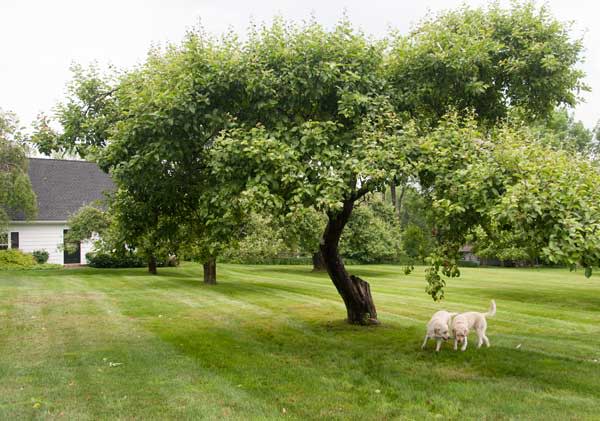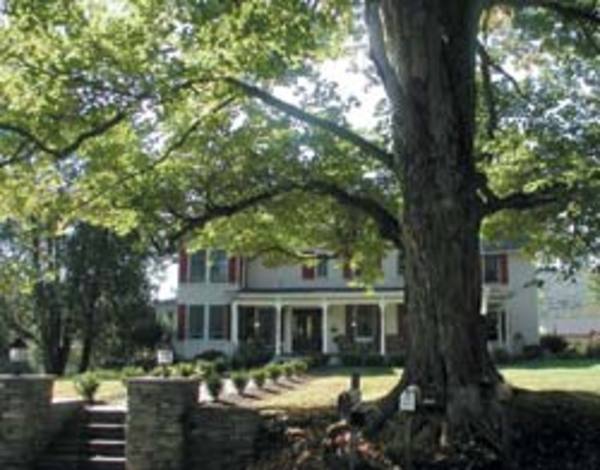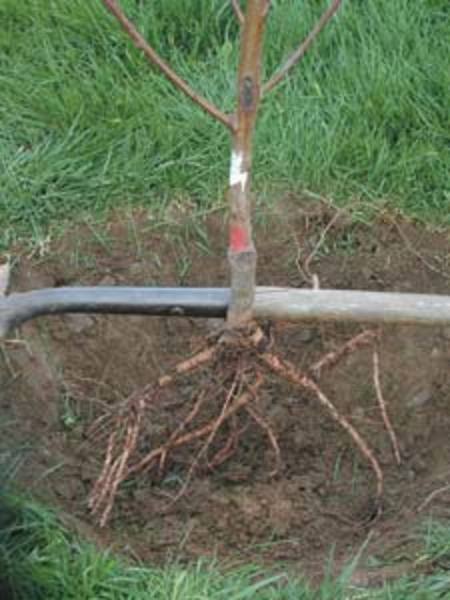By Lee Reich (Article and Photos)

Yellow Labs Lily and Maggie play behind the house, where five trees remain from a former apple orchard.
I’d like to thank the gardener that planted the Norway spruce that is now 70 feet high in my front yard, but even if I knew who that person was, he is surely long gone. We should all be grateful to our forebears for the aged sugar maples, plane trees, and beeches that surround our old houses. Like our ancestors, we should plant new trees that will shade and enrich future generations. Fortunately, it’s easy to plant successful trees if you follow a few simple steps, despite some persistent gardening advice to the contrary. Dispelling some of these long-held myths can help you grow towering trees of your own to beautify the landscape and endear you to future old-house owners.

Towering, aged trees are an important part of old-house landscapes, and a legacy you can leave for future generations by following some simple steps.
Size Isn’t Everything
Let’s start with the popular idea that bigger is better both for saplings and for the holes necessary to support them. If a tree and hole couldn’t both be large, one old maxim advised, it was better to plant a $5 tree in a $50 hole than a $50 tree in a $5 hole. New research published by the International Society of Arboriculture supports that advice by showing that big trees aren’t better for planting. Because small trees experience less root loss when transplanted, they establish themselves more quickly, usually overtaking their larger counterparts after just a few years. Furthermore, the root loss in a large tree means it will be dependant on you for watering until its roots can forage for enough water to support the tree. You’ll need to water a large tree as much as 10 gallons per week for two or more years, while a small tree could be on its own after just a few weeks. I like to plant trees that are two to four feet high and have been grown in a container about a third of the tree’s height or dug out with bare roots while the tree is leafless and dormant. At this size, the tree is firmly established and has energy reserves, but is not so big that it needs excessive care after transplanting.
So much for the $50 tree. As for the $50 hole, save your back and don’t plant a tree any deeper than it was in its container or in nursery soil (look for the soil line on the trunk). In addition, the roots need to sit on a firm base of undisturbed soil, or the tree tends to sink over time and suffer trunk rot. The ideal hole should be two to three times as wide as the spread of the roots, deep enough at the center so that the new soil line matches the old, and gently tapered in between.
The Hole Perspective
If you followed the advice in old gardening books, your hard work wasn’t finished once you dug the hole; experts also advised improving the drainage by lining the bottom with loose material, be it gravel or upturned sod. We now know that these materials do more harm than good because they drastically alter the soil’s porosity, causing water to accumulate and reducing drainage.
Another piece of advice to disregard is the need to mix organic materials such as compost into the soil. The theory was that rich, fluffy soil fed the tree and got it off to a good start. Unfortunately, roots surrounded by organically charged soil have little incentive to reach out into the ground seeking nutrients. Instead, they circle around their planting hole and eventually strangle themselves. Furthermore, organic materials don’t do much good buried deep in the ground where air, feeder roots, and biological activity are diminished. The place to put organic materials is above ground, where they promote the growth of feeder roots, conserve water, and protect the surface from being compacted, sealed, or otherwise damaged by intense sun, wind, and rain.
Once you settled your new tree into the ground, tradition demanded pruning the branches back so as not to overtax a root system weakened by transplanting. We now understand that hormones produced in the tips of branches stimulate root growth and that new plantings should be pruned as little as possible. When pruning is needed, cut off a few branches entirely, specifically those that are grossly misplaced or obviously dead or diseased. In a windy site, cut away enough branches to let the wind pass through so that your as yet unrooted tree doesn’t blow away.

To test the depth of a planting hole lay a shovel across it; the entire root ball should sit below the handle.
Put the Brakes on Stakes
That brings us to staking. Many people think that all young trees should be staked when in fact, a little movement is good. It strengthens a trunk, thickening it and giving it a healthy taper from top to bottom, and also stimulates root growth. So while staked trees might grow taller than their unstaked counterparts, their trunks are weaker and their root systems more sparse.
Of course, sometimes it is necessary to stake a young tree if wind, overly wet soil, or a dense crown causes the root ball to rock back and forth, which constantly rips the tender new root growth. The tree also should be carefully staked if a spindly trunk can’t support the tree’s head, the top is disproportionately large for its roots, or the soil beneath the tree moves when you push the trunk back and forth. To stake the tree, secure it with ties loose enough to avoid abrasion where they make contact and placed about two-thirds of the way up the trunk. Remember that staked trees should still have some motion in the trunk and be able to move freely at the top. For most trees, the major hazard of staking is that people forget to remove the stakes, which can delay the development of a sturdy trunk or create one that is constricted and damaged by ties. For most small trees, remove the stakes after a year. Large trees might need stakes left in place for two years until the tree can hold itself up and the soil beneath it doesn’t move when the trunk is rocked.
Ignoring the final tree-planting myth—that spring is the time to plant—may be the most counterintuitive. While spring weather brings on the urge to garden, autumn planting has many advantages. In autumn, the soil is generally moist and crumbly, making digging easier. Because roots grow at soil temperatures as low as 40 degrees Fahrenheit, the summer heat still trapped in the ground often induces root growth in autumn, and because the shoots remain dormant through cold weather, there’s little chance they will sprout before the roots have nestled into the ground. Come spring, the plants are in place and ready to grow.
Lee Reich writes about planting trees in Weedless Gardening (Workman Publishing, 2001).







